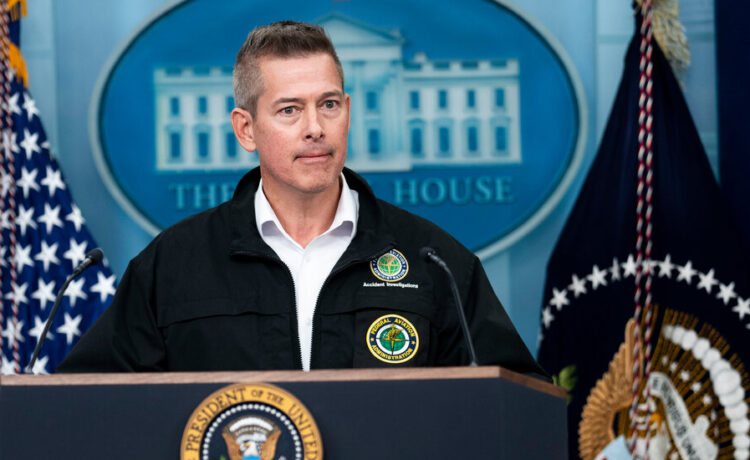The day after Sean Duffy was confirmed as President Trump’s transportation secretary, he signed a memo dictating how federal transportation funds should be allocated.
The list of new criteria included one directive that stood out: All of the department’s grant and loan programs should prioritize projects in “communities with marriage and birthrates higher than the national average,” to the extent allowed by law.
It is not unusual for new administrations to apply different standards to funds that their agencies hand out. But some advocacy groups and policy experts said they found the move puzzling and were unsure how it connected to the Trump administration’s overall transportation goals.
In a statement, the Transportation Department said the order would help advance Mr. Trump’s agenda “to support economic development and strengthen American families by focusing on real, measurable benefits rather than ideological considerations.” The department did not respond to requests for further comment.
Some conservatives, including Elon Musk and Vice President JD Vance, have fixated on America’s declining birthrate, viewing it as catastrophic for the national economy as retired people start to outnumber younger workers, and reflective of eroding family values. But it remains unclear how directing more transportation funding to areas with higher birth and marriage rates would reverse the trend.
“It’s hard to know what sort of transportation policy would promote fertility or marriage,” said Scott Winship, the director of the Center on Opportunity and Social Mobility at the conservative American Enterprise Institute. “You could imagine that someone might think if we had more bike lanes people might have more kids, but there’s just not good evidence that any of that is going to be effective.”
Prioritizing areas with higher birthrates would, however, send more federal funding to Republican states. South Dakota, Alaska, Nebraska, North Dakota and Texas are among the states with the highest fertility rates, according to data from the Centers for Disease Control and Prevention. States that have the lowest fertility rates include Vermont, Oregon, Rhode Island and New Hampshire, none of which voted for Mr. Trump in the 2024 election.
“Clearly this is helping red states,” said Phillip Levine, an economics professor at Wellesley College who has studied the topic of falling U.S. birthrates.
Marriage rates are less correlated with partisan leanings. States with the highest marriage rates include Nevada and Hawaii, which fall on opposite sides of the partisan divide, although red states like Montana, Utah and Arkansas also top the list, according to C.D.C. data.
Even if the policy does not result in more babies being born, directing transportation dollars to areas with higher birth and marriage rates could help parents in those places, Mr. Levine said.
Brad Wilcox, a senior fellow at the Institute for Family Studies, noted that the new criteria would effectively prioritize suburban highway projects, rather than urban public transit — something he viewed as a positive for growing families, since many find raising children in cities to be difficult.
“This policy will reorient transportation dollars to lower-density communities where there are more single-family homes, family life is often more affordable, and family formation is higher,” Dr. Wilcox wrote in an email. “I think we can expect many more creative family policy moves of this kind from this administration.”
Conservatives praised the department’s new guidance. Kevin Roberts, the president of the Heritage Foundation think tank, called it a “fantastic move.”
“This is exactly the kind of pro-family policy we need to put children, parents, and marriage back at the center of politics,” Mr. Roberts wrote on the social platform X. “It’s time to Make America Kid-Friendly Again.”
Some transportation policy researchers said they were not sure if the change would help direct funding to areas that could benefit most from federal transportation funding.
“It’s extremely unusual,” said Adie Tomer, a senior fellow at the Brookings Institution who specializes in infrastructure policy. “We don’t know if this aligns at all with the places most in need of federal support.”
The Transportation Department was authorized roughly $600 billion as part of a 2021 bipartisan infrastructure bill, which President Joseph R. Biden Jr. signed into law. The bulk of those funds is directly distributed to states, but the department was also given billions of dollars to dole out as competitive grants.
The Biden administration’s priorities included making transportation infrastructure more resilient to climate change, investing in disadvantaged neighborhoods and increasing safety for pedestrians and cyclists as well as drivers. For instance, the administration rolled out a $4 billion program that sought to reconnect communities of color that had been split by highways.
Mr. Duffy’s memo will likely reorient the allocation of funds to different places and for different purposes.
The memo also directed the department to give preference to projects that “require local compliance or cooperation with federal immigration enforcement” and to direct funding to places designated as federal opportunity zones. It also criticized the use of the “social cost of carbon,” a metric that quantifies the damage from climate change caused by fossil fuel emissions, when considering where to invest, and required the use of cost-benefit analysis, which may minimize concerns around environmental impact and racial equity.
Ben Casselman contributed reporting.














